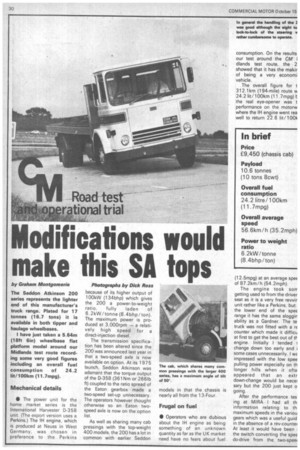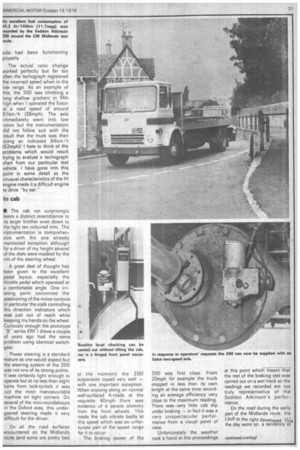Modifications would make this SA tops
Page 32

Page 33

If you've noticed an error in this article please click here to report it so we can fix it.
• The power unit for the home market series is the International Harvester D-358 unit. (The export version uses a Perkins.) The IH engine, which is produced at Neuss in West Germany, was chosen in preference to the Perkins Photographs by Dick Ross because of its higher output of 100kW (134bhp) which gives the 200 a power-to-weight ratio, fully laden of 6.2kW/tonne (8.4bhp/ton). The maximum power is produced at 3,000rpm — a relatively high speed for a direct-injection diesel.
The transmission specification has been altered since the 200 was announced last year in that a two-speed axle is now available on option. At its 1975 launch, Seddon Atkinson was adamant that the torque output of the 0-358 (361Nm or 266Ib ft) coupled to the ratio spread of the Eaton gearbox made a two-speed set-up unnecessary. The operators however thought otherwise so an Eaton twospeed axle is now on the option list.
As well as sharing many cab pressings with the top-weight 400 models, the 200 has a lot in common with earlier Seddon
consumption. On the results our test around the CM I dlands test route, the 2 showed that it has the makir of being a very economi vehicle.
The overall figure for t 312.1km (194-mile) route IA 24.2 lit/100km (11.7mpg) the real eye-opener was t performance on the motorw where the IH engine went rea well to return 22.6 lit/1001,
(12..5mpg) at an average spec of 87.2km /h (54.2mph).
The engine took sorr getting used to from the driver seat as it is a very free revvir unit rather like a Perkins, but the lower end of the spec range it has the same sloggir ability as a Gardner. The te truck was not fitted with a rE counter which made it difficu at first to get the best out of tb engine. Initially I tended change down too early and i some cases unnecessarily. I vs,impressed with the low spee pulling power especially on th longer hills when it ofte appeared that an extr down-change would be nece: sary but the 200 just kept o going.
After the performance tes ing at MIRA I had all th information relating to th maximum speeds in the variou gears which was a useful guid in the absence of a rev-countei At least it would have been the switch converting the spec do-drive from the two-speel axle had been functioning properly.
The actual ratio change worked perfectly but far too often the tachograph registered the incorrect speed when in the low range. As an example of this, the 200 was climbing a long shallow gradient in fifth high when I operated the Eaton at a road speed of around 61km/h (38mph), The axle immediately went into low ration but the instrumentation did not follow suit with the result that the truck was then doing an indicated 84km / h (52mph)! I hate to think of the problems which would result trying to analyse a tachograph chart from our particular test vehicle. I have gone into this point in some detail as the unusual characteristics of the IH engine made it a difficult engine to drive "by ear."
• The cab not surprisingly bears a distinct resemblance to its larger brother even down to the light tan coloured trim. The instrumentation is comprehensive with the one already mentioned 'exception although for a driver of my height several of the dials were masked by the rim of the steering wheel_
A great deal of thought has been given to the excellent pedal layout, especially the throttle pedal which operated at a comfortable angle. One irritating point concerned the positioning of the minor controls in particular the stalk controlling the direction indicators which was 'lust out of reach while keeping my hands on the wheel. Curiously enough the prototype "13" series ER F I drove a couple of years ago had the same problem using identical switchgear.
Power steering is a standard feature as one would expect but the steering system of the 200 was not one of its strong points. It was certainly light enough to operate but at no less than eight turns from lock-to-lock it was not the most manoeuvrable machine on tight corners_ On several of the mini-roundabouts in the Oxford area, this undergeared steering made it very difficult for the driver.
On all the road surfaces encountered on the Midlands route (and some are pretty bad at the moment) the 200 suspension coped very well — with one important exception. When cruising along on normal well-surfaced A-roads at the requisite 40mph there was evidence of a severe shimmy from the front wheels. This made the cab vibrate badly at this speed which was an unfortunate part of the speed range for it to occur, The braking power of the 200 was first class. From 20mph for example the truck stopped in less than its own length at the same time recording an average efficiency very close to the maximum reading. There was ,very little cab dip under braking -in fact it was a very unspectacular performance from a visual point of view.
Unfortunately the weather took a hand in the proceedings at this point which meant that the rest of the braking test was carried out on a wet track so the readings we recorded are not truly representative of the Seddon Atkinson's performance.
On the road during the early part of the Midlands route, the t pull to the right develoPed.-this the day wore on, a tendency to






















































































































